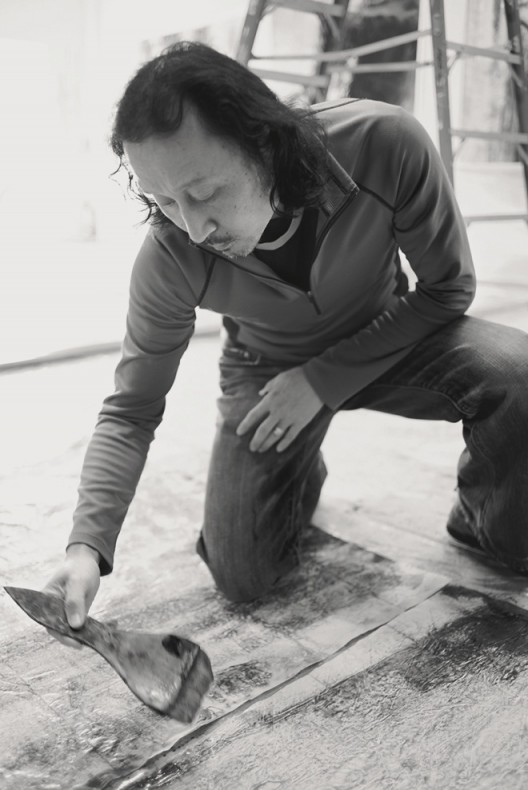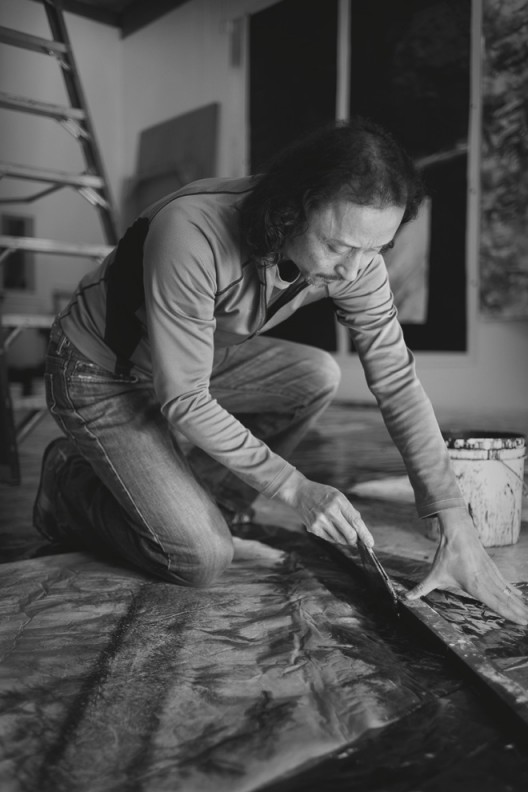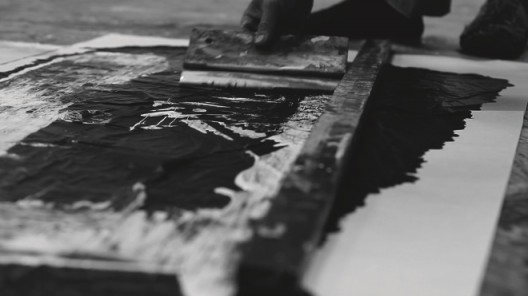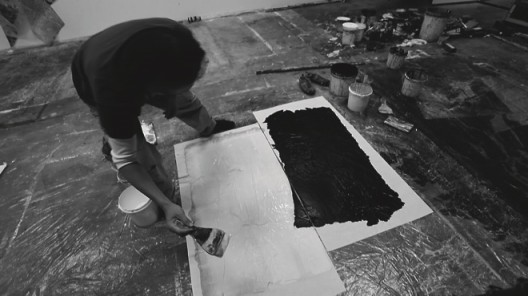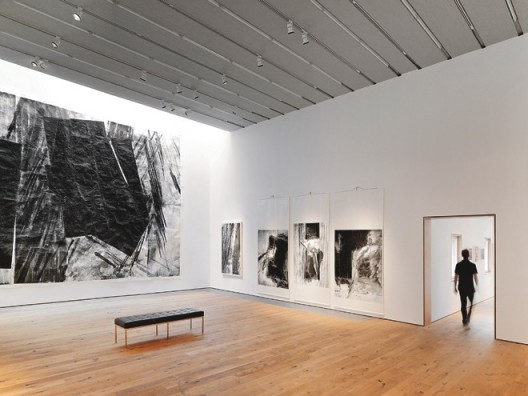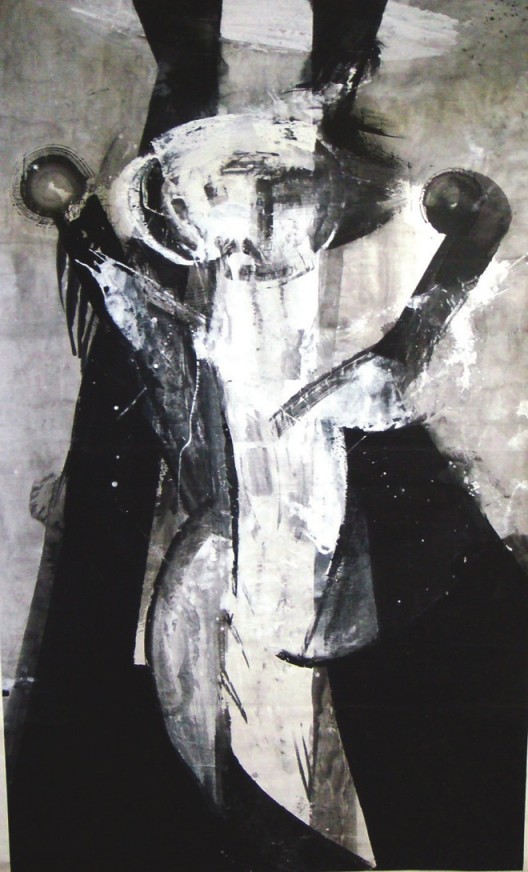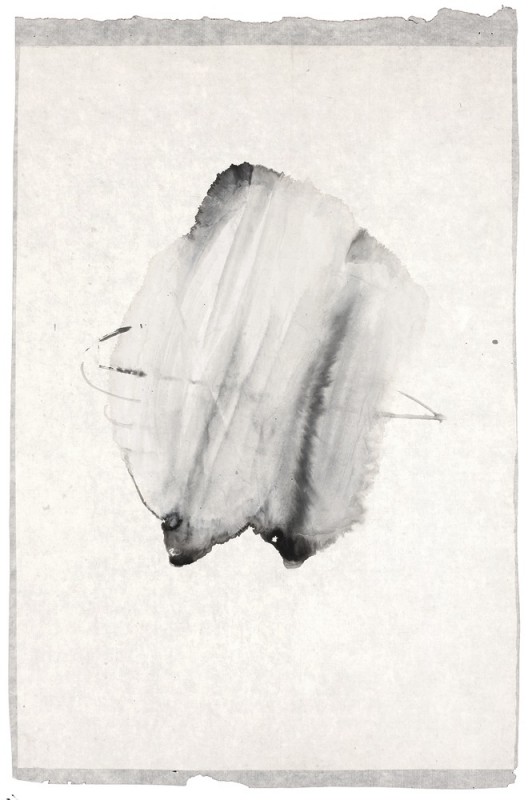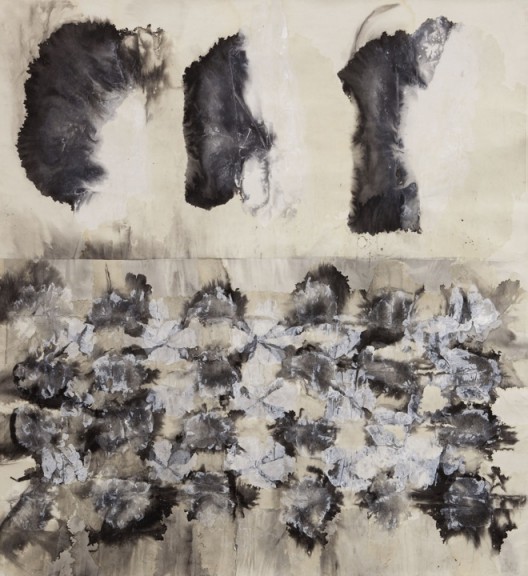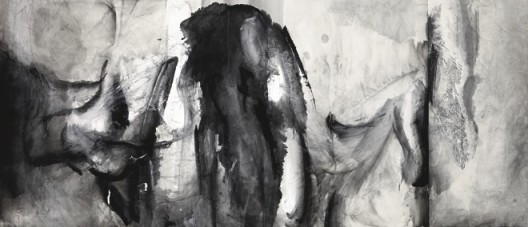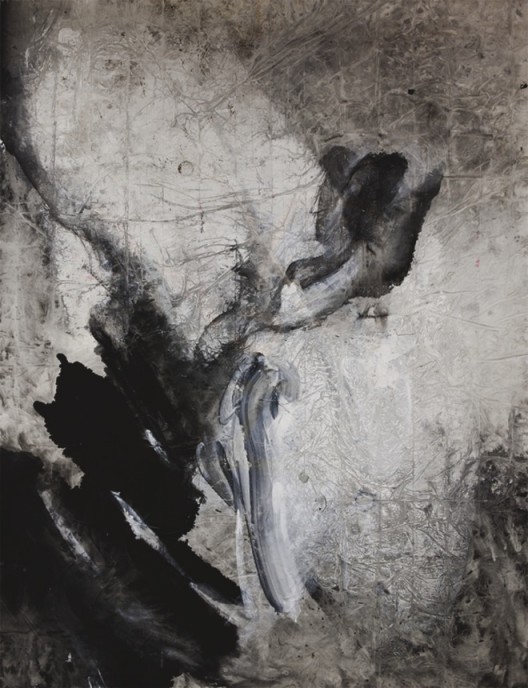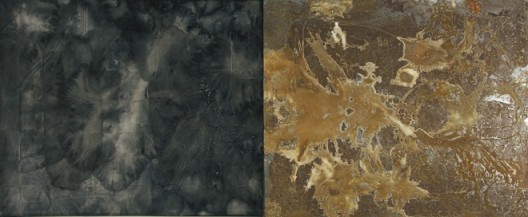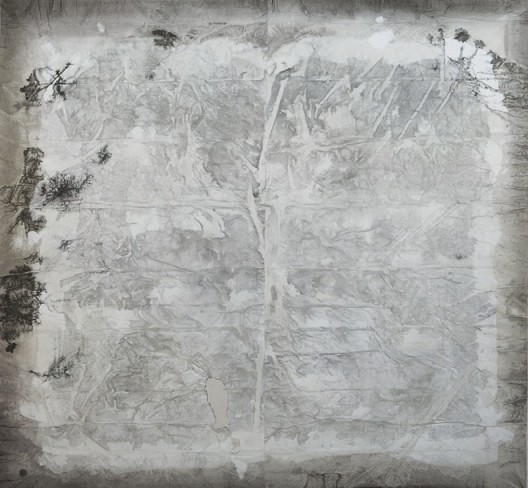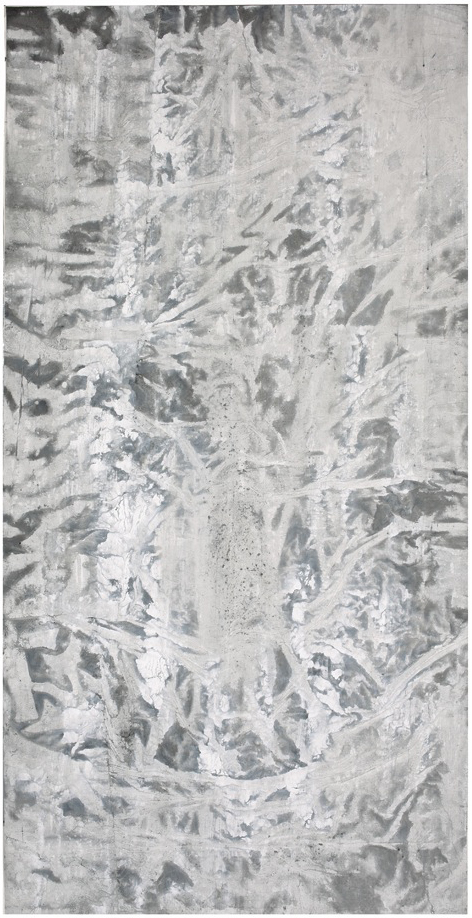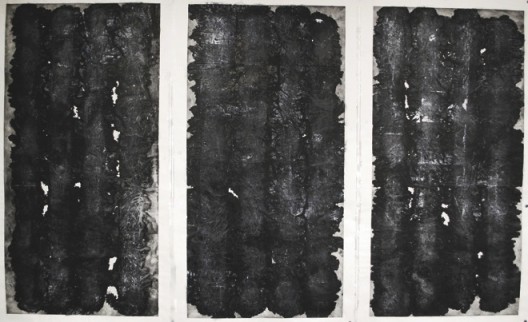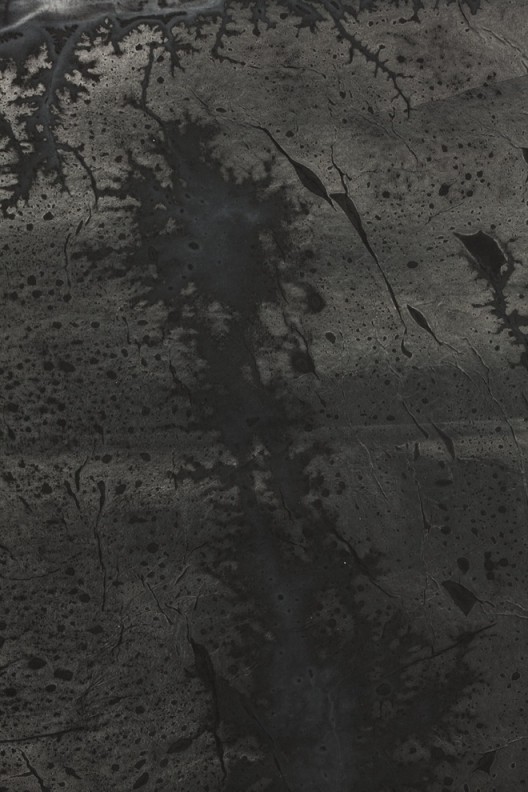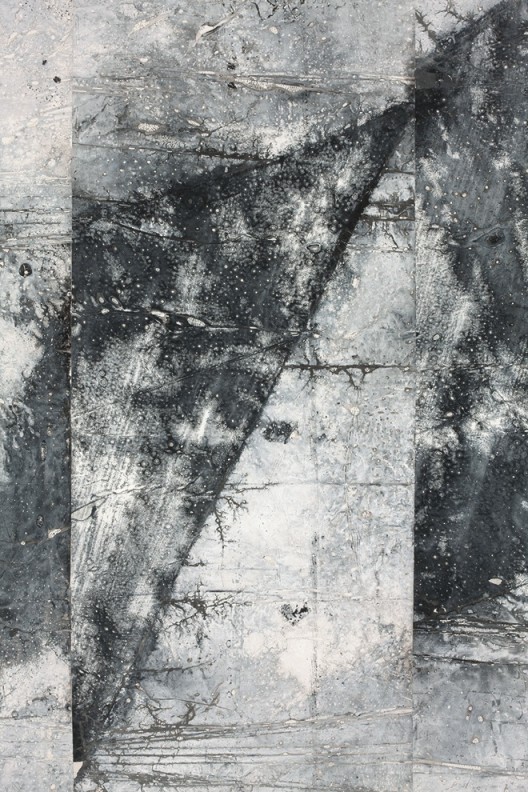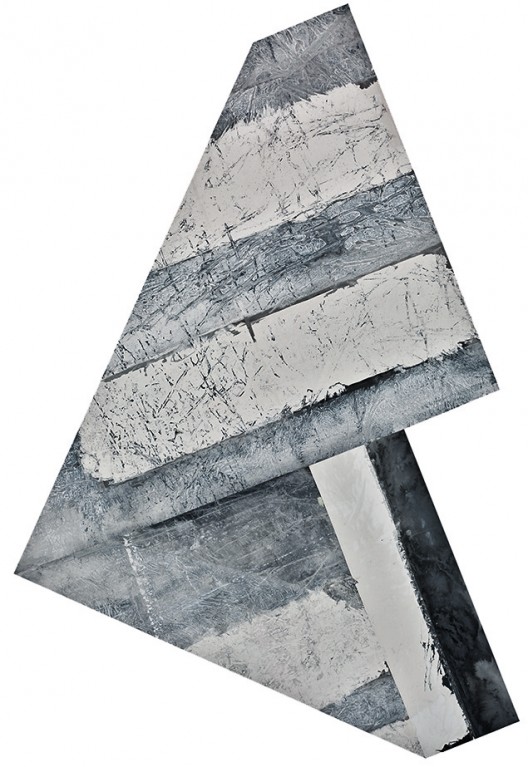Ran Dian Ink
This article was originally published by Ink Studio, Beijing.
It is too early to decide if I am destroying the tradition of ink painting.
—Zheng Chongbin [1]
It is hard to understate how controversial Zheng Chongbin’s abstract ink painting is in relation to China’s two-millennia-old tradition of brush-and-ink-based art:
His forms have reached pure abstraction, severing any mimetic ties to nature or natural forms;
He abandons traditional brushwork and in the process absents the artist’s ego, along with the calligraphic gesture that signifies it;
He sullies the material purity of the age-tested trifecta of calligraphic brush, ink, and paper by introducing a modern material-white acrylic;
He leaves little of the painted surface untouched, so that empty ground no longer serves as a space of generative emptiness; and
He exchanges the subjective space of mental interpretation for the concrete space of sense experience.
Not wantonly but systematically, he seems to question, one by one, the conceptual foundations of classical Chinese ink painting. And yet somehow, Zheng Chongbin manages to create images, forms, and objects that not only embody an ancient Chinese cosmogony but simultaneously reflect our contemporary human experience. How is this possible?
THE ORIGINS OF ABSTRACTION
Images are the means to express ideas. Words are the means to explain the images. . . . The ideas are yielded up completely by the images, and the images are made explicit by the words . . . “the fish trap exists for the sake of the fish; once one gets the fish, he forgets the trap.” If this is so, then the words are snares for the images and the images are traps for the ideas.
—Wang Bi [2]
The theoretic origins of abstraction in Chinese art go back to neo-Taoist Confucian philosopher Wang Bi 王弼 (226–249) of the early Six Dynasties (220–589). [3] Wang Bi points to the ancient divination text the Yijing 易经 (Classic of Changes), and the creation of the trigrams and hexagrams from the observed patterns of the physical, organic, human, social, and psychological worlds, as the archetypal example of abstraction in Chinese thought (fig. 1). [4]

Figure 1: Wang Bi’s conception of abstraction in the form Ideas, Images, and Words is preceded by the perception of Nature and its underlying principles.
In the mind of a sage, observation of the natural world yields the patterns and principles, or yi 意 (idea), by which it is ordered. To capture these principles, the sage creates xiang 象 (images), abstract symbols and diagrams that give visible form to the perceived patterns and principles of this order. [5] To communicate and disseminate these principles, the sage uses language, yan 言 (words), to explicate the images. In the case of the Yijing, the trigrams and hexagrams are the images (fig. 2), and the appended text and commentary are the words. The Yijing‘s systematic process of abstraction from observation to underlying principle, and the representation of principle in abstract image or symbol, became one of the most persistent memes within Chinese culture, to which was attributed the origins of both China’s distinctive ideographic written language [6] and its pictorial art of brush-and-ink painting. [7]

Figure 2: The fourth hexagram, Meng 蒙 (primordial ignorance), for example, consists of two trigrams, Kan below and Gen above, that themselves correspond to the natural Images: shui 水 (water) and shan 山 (mountain) respectively. According to Wang Bi, Meng signifies the state of youthful ignorance that can be corrected through moral education. The seminal seventeenth-century painter Shitao combined “meng” with the word “yang” 养 (nourishment) to signify the power that ignorance bestowed upon an artist, allowing the artist to cultivate him or herself in the freedom of “ignorance,” and thereby transform or renew human art and culture.
ABSTRACTION IN PAINTING
The meaning of ink painting resides in the transformation of object to idea and idea to image. As the emotions arise in response to nature, they are transported from the visible to the invisible world, from reality to its interpretation. Scenes and sights inspire: some of them have definite forms, others are formless; some are elusive, others substantial. Painted forms are distillations of these perceptions a process that lies beyond most words.
—Zheng Chongbin [8]
Over the next two millennia, Wang Bi’s basic observation about the nature of abstraction would find ready application in the realm of art. [9] In particular, during the Six Dynasties, Wang Bi’s ideas had a profound effect on the arts of music, calligraphy, painting, and poetry, all of which drew upon his conceptualization of abstraction. [10] Like Wang Bi’s sage, the artist attunes himself to the reality outside himself (Nature), perceives its underlying principles (Idea), and embodies these principles in an artwork (Image) by which a viewer, through a process of “reading,” perceives these same principles (fig. 3).
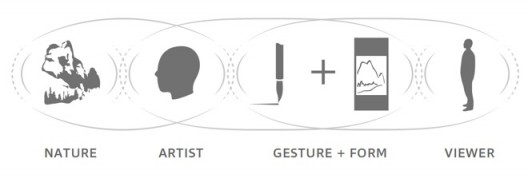
Figure 3: In Six Dynasties aesthetic formulations, the Artist’s perceptions of Nature are transmitted to the Viewer through three stages of resonance: between Nature and Artist, Artist and Artwork (Gesture + Form), and Artwork and Viewer.
In the field of painting, the Six Dynasties artist and critic Xie He 谢赫 (active 6th century) developed six defining principles of Chinese brush-and-ink painting — his Liufa 六法 (Six Laws) — based on Wang Bi’s concept. [11] In his first law — qiyun, shengdong 氣韻, 生動 (Vital Resonance [in] the engendering of movement)[12] — Xie He establishes as the defining desideratum of Chinese painting qiyun 气韵 (vital-energy resonance) or, simply, “resonance.”
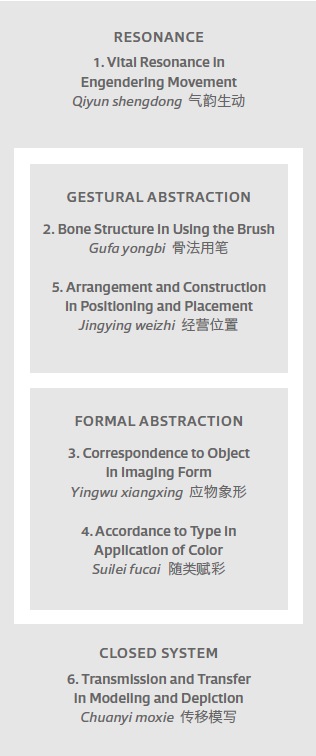
Figure 4: Xie He’s Six Laws can be broken down into an overall governing principle of resonance (qiyun shengdong) realized through gestural abstraction—in the form of brushwork (gufa yongbi) and structure (jingying weizhi)—and formal abstraction—in rendering of naturalistic form (yingwu xiangxing) and color-tone (suilei fucai)—all contained within a self-defining, closed system (chuanyi moxie).
Qi 气 (vital energy) can have many meanings: in Chinese cosmology, it means “the substance of the material universe”; in traditional life science, it means “vital energy”; to our physical bodies, it means “breath” or “pulse”; in psychology, it means “temperament” or “character”; and in aesthetics, it means “air” or “style.” Modern science has given us a contemporary definition of qi that fits all of these traditional notions: energy, particularly energy that flows and supports ordered pattern and form. We, and the phenomenological world that surrounds us, are made of and are nothing more than qi.
Yun 韵 (resonance) is primarily an aesthetic term used to describe a perceptual experience: in poetry, it means “rhyme,” and in music, it means “tonal harmony” and “rhythm.” Simply put, when one pattern reverberates in sympathetic resonance with another, this is yun. Yun, therefore, is not an esoteric concept but rather an experience essential to our human nature: when we sing or dance, tap our feet to a catchy tune, this is yun; when we feel a sense of awe when confronted with the grandeur of the natural world, this is yun; when we empathize with the ones we love or feel compassion toward another living being, this too is yun. Recent scientific research tells us that yun is an essential capacity of human neurology [13] — both an intrinsic and distinctive part of human nature.
Qiyun, therefore, describes a direct and non-rational epistemology of perception — a direct and intuitive means by which we extend our selves to the reality of which we find ourselves a part; it is perhaps the only way by which we connect the outer world to our experience within. When the artist resonates with the natural world through a process of perceiving, she or he is experiencing qiyun. Similarly, when a viewer communes with a work of art and through it perceives the mind of the artist, qiyun is again the essential means. As Zheng observes, “the Chinese approach an object under observation subjectively, seeking to find its essence, meaning, and rhythm within one’s personal experience. . . . The aesthetic contents of Chinese ink painting differ from that of any other aesthetic system in that the presence of qiyun (vital resonance) is always the core requirement.” [14]
Between the artist’s primary experience of qiyun and the viewer’s parallel experience of qiyun, the carrier of this resonance-based sharing of perceptual experience is the media of brush, ink, and paper. In Xie He’s formulation, the artist accomplishes this using two mutually reinforcing means: gestural abstraction, which takes the form of brush and ink marking on paper, and formal abstraction, which requires the imaging of natural form in a manner that is both mimetic and poetic (fig. 4). [15] As a contemporary artist, Zheng Chongbin’s objective is not to perpetuate Xie He’s framework but to question it, and by questioning it to transmute it into a form reflective of our experience today. First and foremost, he asks if it is possible to achieve qiyun without relying upon Xie He’s time-tested formulation of gestural and formal abstraction.
Qiyun in Chinese ink painting is grounded in the artist’s choice of materials. The round, symmetric, soft, and pliant calligraphic brush is a tool used by the artist to manipulate and deploy the medium, ink, into a natural and absorbent ground. Water is the hidden fourth material, which the artist uses to dilute the ink to produce an infinite variety of tones, to change the texture and responsiveness of the brush, and to control the absorbent properties of the ground. The Chinese perfected these materials in the Han Dynasty (206 BCE–220 CE)[16], and Chinese artists, painters, and calligraphers employed them without questioning for the next two millennia.
Certainly one reason for this enduring commitment to the medium was the way in which the responsiveness, subtlety, and expressive range of the materials enabled painters to produce images that were both compelling and nuanced. More important, however, was the almost perfect means by which brush, ink, and paper, and the process of creating an image with them, aligned with cosmogonic principles of creation and humanist principles of morality fundamental to early Chinese thought. The seventeenth-century monk painter Shitao 石涛 (1642–c.1707) states in his Remarks on Painting, “[The Primordial Mark] is fundamental to depicting everything in existence, and is the root of all images. It is perceptible spiritually yet works mysteriously in the human mind,” [17] and later, “when one line is laid down, a multitude of lines follows. When one principle presently forms, a host of principles clings to it. Discerning the path of the Primordial [Mark], one will reach the limit of reason.” [18] The dialectic of gesture marking paper thus corresponds to the cosmogonic principle of form emerging from void, and defines the space (paper, emptiness, mind) within which the brush-and-ink mark (action, form, idea) resonates. This primordial act of releasing the immanent potential of empty space on the painted surface and in the minds of both artist and viewer is the source of qiyun. Brush and ink, as the tools of gesture, and paper, as the space of resonance for the gestural act, form a material trifecta inseparable from the principle of qiyun.
BRUSH
The brush applies the ink with its dynamic spirit . . . the brush becomes spirited only if infused with the energy of life.
—Shitao [19]
The concept of gesture embodying emotion and feeling is simple to grasp and readily available to direct experience. Our automatist somatic response to the trace of the brush in calligraphy and painting enables us to respond to and even empathize with the feelings of the writer or painter. Furthermore, the dialectic of shi 实 (solid) and xu 虚 (void), of gesture marking paper, elevates gesture beyond emotional expression to a level of temporal and spatial resonance; like music, brushwork is physical performance, visceral experience, and mental perception all in one.
An essential criterion of good brushwork is the application of calligraphic standards in the use of the brush. Xie He’s second law, regarding the use of bone structure in brushwork, reflects a parallel principle in calligraphy whereby the form of a stroke and its spatial relation to other strokes must capture strength, structure, and force. [20] Zheng describes the implications for painting: “When it comes to the presentation of such prescribed forms or symbols, what is valued and required is a particular manner of using the brush in accord with calligraphic techniques . . . the placement of brushstrokes, ink, forms, and movements follows the methods of calligraphy in which space is interspersed among characters in ways that enhance brush movement and ink tones.” [21]
A risk to the artist from this kind of practice, however, arises from a desensitization of his brushwork caused by calligraphic repetition. To address this shortcoming, Zheng adopted the flat paibi 排笔, or mounter’s brush, in place of the soft, round, and symmetric maobi 毛笔 favored by calligraphers, as a way of breaking his hand’s dependence on calligraphic standards. He recounts, “My first experiment was to use the paibi, a wide brush used for mounting paintings. I found that it changed my gestural behavior. It changed how I approach my work in terms of structure rather than through formulated cohesive brush movements.” [22] This simple change in tools freed him to be “raw” (sheng 生) and “authentic” (zhen 真) (fig. 5). [23]
Calligraphy, however, is more than technique. As a physical performance that triggers an automatist response in the viewer, calligraphic brushwork is a gestural and performative carrier of qiyun — more specifically, a carrier of resonance from one person to another. From this arose the idea that one could discern both the underlying character and the momentary emotion of a writer through his calligraphy. Furthermore, much as humans and other social mammals learn from imitating a role model, the Chinese believed that one could absorb and embody the virtues of a past master by copying, or reperforming, his calligraphic style.
Zheng Chongbin argues that because of the autographic nature of calligraphy, the traditional artist’s identity and ego are inseparable from his brushwork. Among other things, this prevents the artist from escaping his ego-bounded perspective and attaining, in his artwork, universal resonance. Although the viewer may identify with the mind or feelings of the artist through the artist’s brushwork, she or he may be prevented from experiencing a reality greater than that of the artist because of this. Zheng describes this as a kind of “hollowed individualism,” or “empty expressionism.” [24]
Today, the situation is even more dire. The audience for whom calligraphic brushwork is an ingrained expertise has all but disappeared. In contemporary society, few people use the brush on a daily basis and, as a result, the automatist response is largely unconditioned. To an untrained audience ignorant to the nuances of calligraphic brush performance and its rich, historic associations, calligraphic brushwork is no different than other kinds of performative gesture.
Zheng’s solution is to embrace a range of non-brush actions [25] — from dripping and pouring to casting, tearing, and folding (fig. 6) — and to embrace “handless,” or egoless, gestures — such as ruled lines and geometric or mathematically defined actions (fig. 7). [26] Unconstrained from the requirements of calligraphy, Zheng dramatically expands the range of actions and choices available to the working process of a contemporary ink artist. “If one simply limits one’s concept to brushwork, then almost inevitably one hews to techniques that are too specific and too narrow. Real meaning must be sought in the concept of ‘bone structure,’ which one can use to transmit vitality through perception, interpretation, and action.” [27]
INK
Ink saturates the brush with its intelligent soul…but will lack intelligence if the artist does not cultivate his potential.
—Shitao [28]
Ink is made from soot produced from burned oil or pine, combined with organic glue. Subsequently ground into fine, microscopic particles and diluted with water or congealed overnight, it can attain an infinite range of tones and textures. The brush, which applies the ink, is “assertive” (yang 陽) — a tool of the artist, it reflects the character and qualities of the artist. Ink, on the other hand, is “receptive” (yin 陰) — a material, it possesses and manifests its own qualities, especially in its interaction with water and the naturally absorbent ground. A brush mark, therefore, is a collaborative act between “Man” and “Nature,” between the artist’s brush and his material medium.
It shouldn’t surprise us that Zheng Chongbin is willing to question the most fundamental assumption of ink painting: the medium itself. In his work he breaks the essential dialectic of assertive brush (and ink) marking receptive paper by introducing an active yin element, white acrylic. By introducing a material white, the opposite of black ink, white is no longer receptive emptiness but an active medium. With the brush, the artist can now manipulate and gesture with white (fig. 8). He states, “My use of acrylic is basically intended to enrich ink painting by adding abstract plastic elements . . . [to] increase the tangibility and tactility of the medium and compensate for the limited means that ink painting relies on. I found that by incorporating acrylic into ink painting, I cleared away barriers to expression: it completed my visual language.” [29]
Concisely described by Kenneth Wayne in his essay, acrylic is a material with dual qualities. [30] Blended with water, it behaves like white ink, absorbing into paper and mixing with black ink. Left thick, however, acrylic behaves like oil paint, lending an opacity that can cover and be covered. By controlling its opacity, Zheng Chongbin can paint over and over with acrylic and construct space in rich and complex layers. As he stated, “Ink can provide layers, but the acrylic can create another layer of space that is completely different than the effect of ink and wash.” [31]
In this sense, acrylic acts like another ground; however, unlike paper, which is purely absorptive and passive, acrylic exerts a physical presence and an agency all its own. Zheng Chongbin writes that “ink is black and so can also suggest white. White, however, is different from emptiness (xu). Because it lacks any chromatic qualities, white embodies an inherent lacking; yet, because it is pure in itself, it exudes a luminous perfection. A blank space allows room for imagination; a white area captures my gaze. Blankness admits contemplation; whiteness asserts its presence.” [32] The resulting space is neither architectural nor illusionistic, nor entirely imagined. It is both viscerally experienced and perceptually constructed (fig. 9).
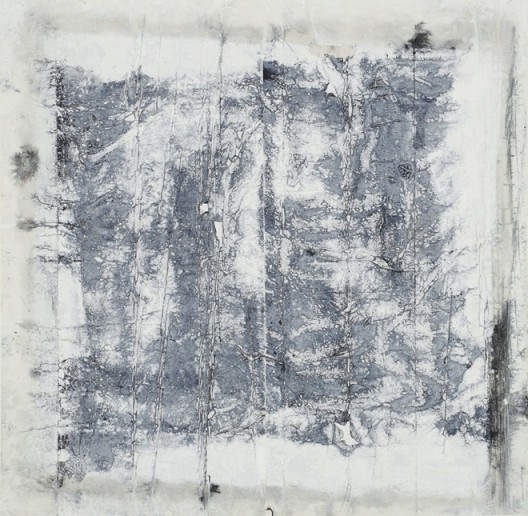
Figure 9: Square Alteration 更改过的方形, 2012, 53½ × 54¼ inches (136 × 138 cm), Collection of Daniel Chen and Jennifer Field.
PAPER
The concept of space in traditional Chinese aesthetics is based on subjective imagery and transcendental experience. The material world is transformed into an imaginary one where the soul can find harbor . . . space [in traditional ink painting] is interpreted rather than physically felt.
—Zheng Chongbin [33]
From the Northern Song onward, Chinese artists abandoned point perspective and illusionistic space, and adopted in its place imagined or mentally constructed space. The concept of xu, “emptiness” or “void,” and its correlation with both untouched paper and an open and receptive mind, is essential to this formulation of space. Just as emptiness is the place of resonance for the Primordial Mark and for the calligraphic gesture, emptiness in the form of untouched paper is the space in which depicted forms resonate with each other and with the viewer’s receptive mind.
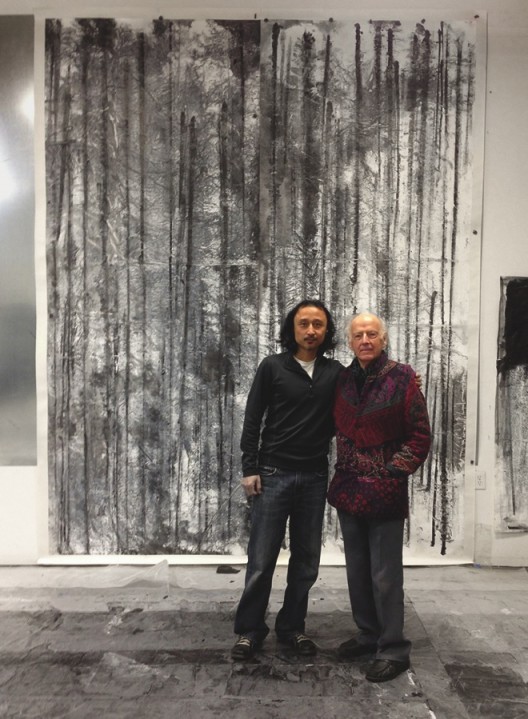
Figure 10: Zheng Chongbin in his studio with Professor Michael Sullivan and “Lines with Volume”, 2011 (plate 27).
As seductively enlightened as this sounds, mentally constructed space places an enormous burden of interpretation on the viewer. Of contemporary viewers, whether Western or Eastern, Chinese or non-Chinese, few have the knowledge and temperament to undertake this process of interpretation. Space and composition are only part of it; form must also be interpreted, as must brushwork and ink tones and textures. A viewer enters the space of a painting with his or her mind and reads the composition, forms, and brushwork — a corollary to the idea that a painter encodes, or writes, his or her ideas when painting. But who today is even literate in this bygone language?
The first concept Zheng Chongbin breaks is the dialectic of shi and xu — the traditional artistic ground of qiyun. By working with acrylic, he makes xu active, turning it, in essence, into shi. In so doing, he risks losing the site, or space, or place of resonance and, thereby, undermining qiyun itself. Zheng’s ground is often completely covered with both ink and acrylic, so that the concept of empty space, or void, appears to be missing. Instead, Zheng puts the real space of the viewer in dialogue with the felt and perceived space inside his paintings. They cease to be representations of an idea to be mentally constructed and read, and instead become concrete manifestations of an idea to be confronted and experienced (fig. 10).
His works resonate not in the mentally constructed space of two-dimensional paper but within the same three-dimensional, physical space that the artist and the viewer share (fig. 11). In this way, he replaces illusory space with physical space as the space of resonance, an experience he describes emphatically by declaring, “I want my paintings seen within architecture and within [an] installation [format]. I want a marriage between installation and paintings. I want a way to look away from painting’s flat surface. I want painting that is connected to the physical space.” [34]
FORMAL ABSTRACTION
Traditional ink painting values perception, the interpretation of an object as it leaves an image in the mind, which is presented in a prescribed form. . . . Ink painting provides a way for the individual to identify himself with nature and bring himself into harmony with society as a whole. This interaction between inner spiritual world and outer physical world leads to aesthetic enlightenment.
—Zheng Chongbin [35]
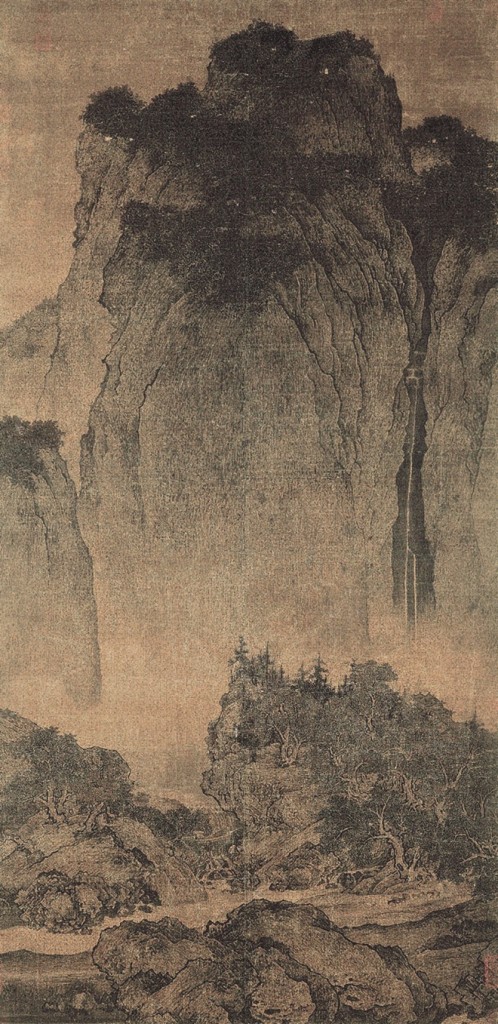
Figure 12: Fan Kuan 范宽 (active 990–1020), “Travelers Among Mountains and Streams” 溪山行旅, hanging scroll, ink, and slight color on silk, Collection National Palace Museum, Taipei.
In classical Chinese cosmology, reality is governed by unseen laws, or principles, called Dao 道 (the Way) in classical Taoism or Li 理 (Natural Principle) in Song Dynasty neo-Confucianism (Lixue 理学). The sage Laozi in his Daodejing observes, “The Dao of all things is elusive and vague. Vague and elusive, yet within it is form.” [36] The principles of “Nature” cannot be seen and yet the only way we can know these unseen laws is through their manifestation in natural form. The same is true for unseen human principles as manifest in behavior, societal principles as manifest in affairs of economy and state, psychological principles as manifest in thoughts and feelings, and spiritual principles as manifest in states of consciousness.
Wang Bi, commenting on the Yijing, asserts that the human mind, when aligned with this world of phenomena, can perceive the unseen patterns and principles that underlie it, and give these principles an analogous abstract form. In Xie He’s world of art, this means that form in painting must be tied to the perception of natural forms — figures, flowers, trees, and landscapes. In Xie He’s time, the moral universe of the artist was thought best represented by the human figure. By Song times, the moral cosmology of the Lixue Confucians was best embodied by the natural forms, specifically landscapes consisting of earth — in the form of rocks, hills, and mountains — and water — in the form of rivers, lakes, streams, and mist (fig. 12).
Interpretation of these natural images is primarily poetic, that is, interpretation through analogy. In this way, a limited set of natural forms can convey meaning relating not just to the natural world but also human affairs, individual psychology, and universal spiritual experience. If brushwork is the music of painting — its melody and rhythm — then natural forms are the text — its lyrics and poetry.
According to Zheng Chongbin, the problem is that the language of classical forms and their literary and philosophical associations is no longer relevant to today’s society. He observes, “Ink as a medium for the visual expression of scholarly concepts has had its day. In new developments in ink painting, there are challenges that cannot be confronted within the vocabulary—or even the conflicts—of traditional ink painting. Responses to these developments are found in the changing methods and the formation of new concepts that arise and become established as times change. The environment and ideas of modern life, contemporary images and systems of visual reference, experiences and values that accrue in the practice of painting, the scope of what is visible and its changing conditions, the expansion of visual experiences through science and technology, the perpetual learning that takes place as our insights evolve — all are factors that affect ink painting in the present that cannot be ignored.” [37]
Some artists have responded by painting subjects familiar to Western art or objects and environments we encounter in contemporary life. Zheng Chongbin, in contrast, moves in the opposite direction, away from objective depiction. He describes form as important, saying, “I found it advantageous to the display of ink to have its rich tonality contained within forms,” [38] but only when synchronized with his non-calligraphic, bodily gestures in a contemporary enactment of qiyun. “[There is] a strong body association in my paintings. . . . For me the biomorphic form involves my coordination and understanding of this medium. And the rhythms of my coordination with this medium are about my own coordination and rhythms.” [39] This move toward biomorphic abstraction shifts the meaning of his paintings away from traditional poetics or polemics to an interpretive realm of abstract principle and felt intuition (figs. 13 and 14).
In search of a more universal conceptual framework from which to address the contemporary issues confronting the ink tradition, Zheng moved to the United States in 1988 and immersed himself in the study of installation and conceptual modes of artistic production at the San Francisco Art Institute. During that time, he observed, “My paintings were always deeply connected to three-dimensional space. But when I first arrived in the Bay Area, I felt that what I did in China was over. I was dropped into a whole new way of thinking — students at the Art Institute were discussing art as public or as conceptual. I paused. I didn’t know if I could continue to paint.”[40]
Zheng Chongbin’s doubts didn’t last. When he returned to ink painting in the 1990s, he did so with a new conceptual rigor. In contemplating Shitao’s 1685 hand scroll titled Wandian E Mo 万点恶墨 (Ten Thousand Ugly Ink Dots)[41] as a conceptual work, Zheng realized that the dot was not only the fundamental element of form construction but the primary unit of brushwork or gestural abstraction — the dot, in other words, was the most elemental linguistic unit of ink painting. “The surface of his ugly-dot-scroll achieves an effect of everything being ink; however, the real meaning of the work is that the dots originate in the dots, are placed within the dots, and end within the dots.” [42] In a series of works from 1997 to 2002, Zheng explored the qualities of the dot and its relation to form and space (figs. 15 and 16), explaining, “Why dots? Dots are the anchor point. A dot is the point that balances the work. It’s the punctuation in a code. Shitao amplified the abstraction of the dot. In my own work, on the lines, where they crossed, I added dots. And then I started to focus purely on the dots, fields of dots — but they’d overlap, bleed into each other, escape my control. . . .” [43] In one unified element, Zheng had rediscovered the common ground of both the gestural and formal dimensions of abstraction. Any connection to the objective was effectively severed.
In a series of works from 2006 to 2009, Zheng Chongbin moved from the dot to the line. In terms of form construction, a line is nothing more than a series of dots, or, in terms of gestural abstraction, a dot with duration. Compared to his essentialist dot paintings, Zheng’s new forms emerge into an enigmatic complexity (fig. 17). Instead of conjuring poetic images, they ask abstract questions, such as, “What is the nature of existence or of becoming (fig. 18)?”
Although Zheng Chongbin’s reformed brushwork freed him of calligraphic constraints, brush gestures still belied the hand and intention of the artist. By 2009, in his essay “Expressions in Ink: The Contemporary Language of Ink Painting,” [44] Zheng had already conceived and idealized a notion of painting, which absented the hand and therefore the ego of the artist (fig. 19). In its place, he posits a method of egoless image formation rooted in the autogeny, or self-manifesting quality of the materials themselves-ink, acrylic, xuan paper, and water.
Beginning with Grey and White (2009) (fig. 20), Zheng started to explore the qualities of acrylic — its luminosity, its diffusion and interaction with ink, its opacity, and its transparency. These “white ink” works, as he calls them, became the focus of a 2011 exhibition curated by Abbey Chen titled White Ink. Pointing to a more recent work, Seduction (2012) (fig. 21), he explains, “It is purely acrylic, ink, and a puddle of water forming itself. I do nothing, I say nothing, because I let the material do the work, improvise itself.” [45]
In a parallel series of works starting with Black (Fluctuating A to C) (2010) (fig. 22) and culminating in the Dark Vein series (2013) (fig. 23), Zheng confronts us with the pure quality of ink, its material texture, its reflective surface, its transformation through water, its mass and gravity. He explains, “There are various layers of matte black, reflective black, mirror-like black, black that conveys a sense of complete material. . . . So here Shitao’s blacks and Ad [Reinhardt]‘s blacks are the black of the black noumenal language and the black of aesthetic wisdom. They are also reified black. In Shitao’s chapter on brush and ink we glean a premonitory feeling that enlightenment can be visually experienced through the independent material states of the ink body.” [46].
As early as 1999, in his larger dot paintings, Zheng Chongbin began exploiting the edge of the paper in his handling of space and started applying water, sealer, ink and acrylic to both sides of the paper. By 2006, he began cutting and reversing the paper so that a single work would show both sides. Then, starting with the seminal work Three Corners (2012) (fig. 24), Zheng began to more actively manipulate the structural nature of paper — its dimensionality, shape, and malleability — through a much broader range of actions, including folding, cutting, reversing, casting, and collaging (fig. 25).
Instead of representing reality through a language of forms, Zheng Chongbin presents us with reality itself through the emergent manifestation of his materials. In the panel titled Qiyun from Zheng’s New Six Canons (2013), for example there appears an image (fig. 26), but an image of what? In answer, I have been offered a river, a tree, lungs, blood vessels, a coastline, the brain, and the universe (fig. 27). Like a Rorschach blot, it can be all of these, but is intended to be none of them. The form itself emerged from the self-manifesting interaction of the work’s constituent materials—ink, acrylic, water, and paper. As Zheng himself describes in Taoistic terms, “there is no meaning in my work . . . my work only has the material characteristic of its own [self], a code of physical evidence that becomes the narrative. As a result, my work cannot be categorized. It is the style of no style.” [47]
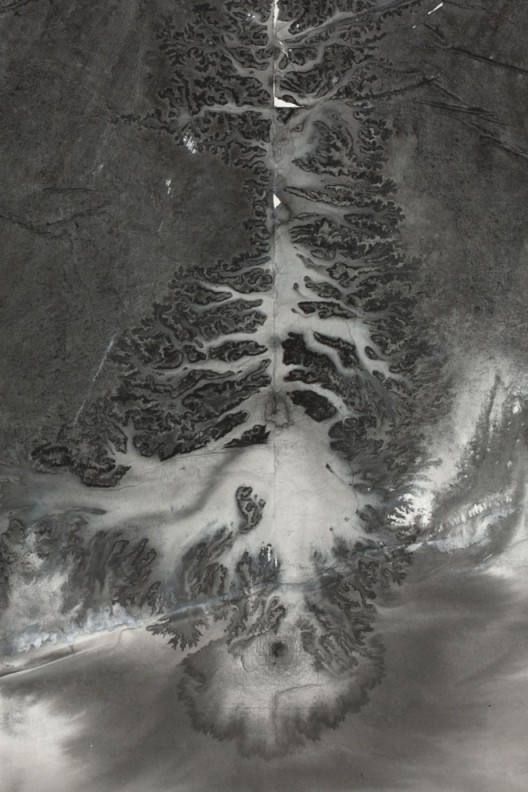
Figure 26: Detail from “Yingwu Xiangxing” 应物象形, New Six Canons 新六法, 2012, set of 6 panels, 90½ × 24⅜ inches (230 × 62 cm) each panel
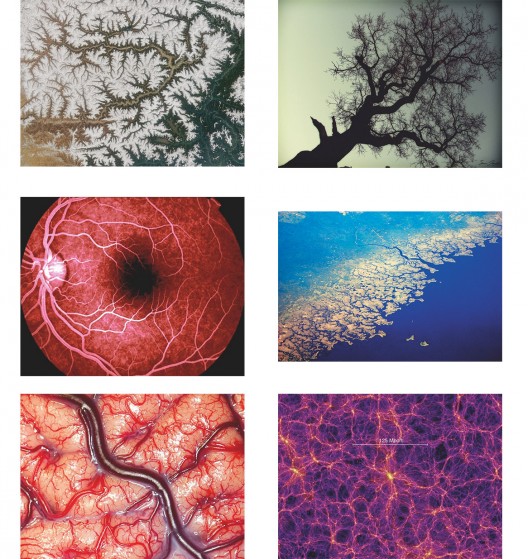
Figure 27: Images of fractals in nature: the Yarlung Tsangpo River, Tibet; a tree; a lung; blood vessels in the retina; a coastline; a brain; the universe.
Just as nature created the rivers to drain the watershed, trees to absorb sunlight, lungs to exchange gases, nets of neurons to sustain consciousness, Zheng Chongbin’s forms emerge through the interaction of these same forces in a reperformance of nature’s cosmogonic cycles of creation and destruction. As he states, “I want the ink to be part of a process . . . of entering into something that is not measureable or mappable, where structure and form are present, but also fall away and dissolve, where something edges its way into the messy process of how we ‘become’ in the world. It’s not about control; just the opposite. It’s about an emotional opening up to that process of becoming.” [48]
CONCLUSION
In the final chapter of his Remarks on Painting, ”Fulfilling Empowerments,” Shitao makes explicit that the purpose of form in landscape painting is to make visible the underlying qualities and formative principles of “Nature”: “Without the empowerment of water by mountains, water’s encompassing flow would not be manifest; without the empowerment of mountains by water, its enveloping shape would not be manifest.” [49] Zheng Chongbin’s idea is nearly parallel; however, instead of giving us an image of “Nature” in the form of “mountains” and “streams,” he provides us with nature — in the materials of “ink” and “water” — manifesting their own forms.
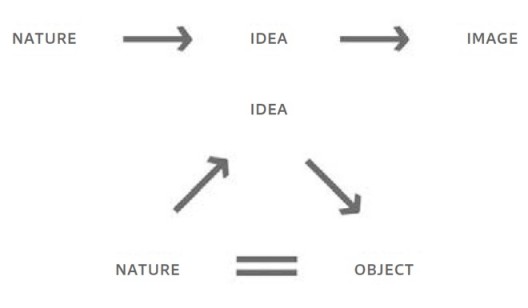
Figure 28: Replacing Image with Object. In Zheng Chongbin’s reworking of Wang Bi, instead of abstracting an image from an idea inspired by nature’s principles, Zheng collaborates with nature to create an object manifestation of those same principles.
Zheng Chongbin’s transformation thus reaches beyond Xie He to question Wang Bi. Specifically, Zheng replaces Wang Bi’s concept of an image created by a sage to reflect natural principles with an object created by an artist that is a direct manifestation of natural principles. Art is not a representation of “Nature” or an idea but rather the direct product of nature in interaction with an idea (fig. 28).
In Zheng Chongbin’s reformulation, the principle of qiyun is the same; one can directly perceive the underlying principles and patterns of nature, society, and mind through resonance with the real, phenomenological world. But instead of art providing an image to represent these principles, Zheng confronts us with an object that visually manifests these same principles. He does this without recourse to calligraphic brushwork and established dialectics between brush and ink and assertive mark on receptive ground, classic notions of mentally constructed space, or traditional poetic interpretations of natural form. In the traditional formulation, the viewer experiences “Nature” indirectly by resonating through a language of gestural and formal abstraction with the mind of the artist who is himself attuned to the Dao. In Zheng Chongbin’s reformulation, the viewer experiences nature directly through the artist’s creation, which is an object manifestation of nature itself (fig. 29). The former must be read, the latter experienced.
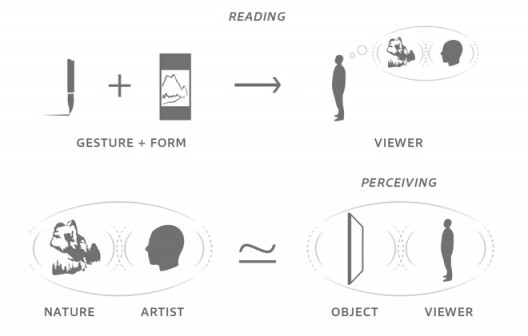
Figure 28: Perceiving in place of Reading. By replacing an image that must be interpreted or “read” with an object that need only be perceived or experienced, Zheng positions the viewer similarly to the artist—that is, in direct resonance with objective reality or nature itself.
If our received notions of gestural and formal abstraction are indeed inseparable from the definition of Chinese ink painting, then what Zheng Chongbin has created may not qualify as Chinese ink painting. [50] If, however, ink art resides in a broader conceptual space defined by essential perceptual criteria such as qiyun and its correlation to natural or cosmogonic principles, then Zheng’s work can be understood as a contemporary extension of aesthetic and philosophical principles intrinsic to Chinese art from its earliest inception. Perhaps Zheng Chongbin is right when he concedes that it is too early to decide if he is destroying the tradition of ink painting because he may, in fact, be doing just the opposite.
———————————————————————————————————————————
[1] Zheng Chongbin, interview with the author, New York, March 14–17, 2013.
[2] Wang Bi, “General Remarks on the Changes of the Zhou [Zhouyi Luili],” Classic of Changes: A Translation of the I Ching as Interpreted by Wang Bi, trans. Richard John Lynn (New York: Columbia University Press, 1994), 31.
[3] Wang Bi 王弼 (226–249) was an intellectual prodigy of the Wei-Jin (220–420) period and an early founder of Xuanxue 玄学 [Abstruse Learning], a blending of Confucian and Daoist philosophy based on study of the Yijing 易经 [Classic of Changes], the Lao Zi 老子, also known as the Daodejing 道德经, and the Zhuangzi 庄子. Although he lived only to the age of twenty-three, it is hard to overestimate his influence on the thinking of his time and of later periods. His commentaries on the Yijing and the Daodejing, for example, established a Daoistic spiritual ideal of non-being, freedom, and natural-ness for the Confucian sage who still led a life fully engaged with society. His interpretation of Dao 道 [the Way] as the non-being from which all phenomena arise forms the basis for future readings of philosophical Daoism as primarily metaphysical and holistic in nature. Of late, Wang Bi has become the subject of intense scholarship, most notably Richard John Lynn’s translations of Wang Bi’s commentaries on the Yijing and Daodejing and Rudolf Wagner’s studies of his language, ontology, and political philosophy.
[4] The Yijing is an ancient divination text that rose to the status of a canonical Confucian classic during the Han Dynasty (206 BCE–220 CE). In the “Great Commentary”, the legendary Fu Xi 伏羲 (c. mid-twenty-ninth century BCE) is credited with the seminal act of abstraction when “he looked up, observing the phenomena of the heavens, and he looked down, observing the ways of the earth. . . . He learned lessons from near and from afar, from his own person and from things outside. And he began to form the Eight Trigrams in order that men may communicate with divine enlightened virtues, and also categorize the nature of ten thou- sand matters.” The Eight Trigrams were subsequently stacked into hexagrams (sixty-four in all) with divination readings attached. Traditionally the text was thought to have been systematized into a philosophical work of tremendous subtlety and depth by the early sages Wen Wang 文王 (1152–1056 BCE), the Duke of Zhou 周公 (c. eleventh century BCE), and Confucius 孔子 (551–479 BCE), each of whom appended a different strata to the final text. Through his astute commentary on the classic, Wang Bi is credited with restoring the tradition of interpreting the Yijing as a work of philosophy focusing on the meanings and principles of the constituent hexagrams. See Wang Bi, Classic of Changes.
[5] In his own focus on the supraverbal relationship between ideas, images, and words, Wang Bi is likely drawing upon the Xici Zhuan 系辞传 [Great Commentary] to the Yijing, a much earlier strata of text traditionally attributed to Confucius. In it, “The Master said: ‘Writing does not exhaust words, and words do not exhaust ideas. If this is so, does this mean that the ideas of the sages cannot be discerned?’ The Master said: ‘The sages established images in order to express their ideas exhaustively.’” Wang Bi, “Commentary on the Appended Phrases [Xici Zhuan], Part One,” Classic of Changes: A Translation of the I Ching as Interpreted by Wang Bi, 67.
[6] As Ronald Egan narrates, “By Han times, it was already conventional to think of the inventory of writing by the legendary Cang Jie 仓颉 as following upon the invention of the trigrams and hexagrams. The way Xu Shen 许慎 (c. 58–c. 147) explains the origins of writing in his preface to Shuowen Jiezi 说文解字 [An Explanation of Phrases and Analysis of Characters]: ‘first there was Bao Xi 庖羲 (Fu Xi 伏羲), who created the trigrams by modeling them on the images he observed in heaven and earth, and then there was Cang Jie, who similarly created writing by modeling it upon the tracks of animals and birds that he observed: According to their category he made images of [the natural] forms, and so called it patterns/writing.’” Ronald Egan, “Nature and Higher Ideals in Texts on Calligraphy, Music, and Painting,” in Chinese Aesthetics: The Ordering of Literature, the Arts, and the Universe in the Six Dynasties, ed. Cai Zongqi (Honolulu: University of Hawaii Press, 2004), 281.
[7] The connection between the Yijing and the art of painting came later than for calligraphy, around the later fourth and early fifth centuries. Until then, painting was seen primarily as a narrative art of moral instruction based on replicating appearance. The portrait artist Gu Kaizhi 顾恺之 (c. 344–406) and the landscape painter Zong Bing 宗炳 (375–443) shifted the focus of painting away from outward appearance toward intrinsic principle. Drawing upon Wang Bi’s concept of images yielding up ideas, Zong Bing observed parallels between artists (sages) realizing ideas (Dao) perceived from nature (things) and the sensitive viewers (the virtuous) stilling their minds (thoughts) in order to appreciate an artist’s creations (images). “Sages, harboring the Dao, respond to things. The virtuous, purifying their thoughts, savor images.” Susan Bush, “Tsung Ping’s Essay on Painting Landscape and the Landscape Buddhism of Mount Lu,” in Theories of the Arts in China, ed. Susan Bush and Christian Murck (Princeton, NJ: Princeton University Press, 1983), 144.
[8] See, in this volume, Zheng Chongbin, “Expressions in Ink: The Contemporary Language of Ink Painting,” 2013.
[9] Perhaps the most recent application of Wang Bi’s conceptualization is Gao Minglu’s 高名潞 Yi Pai 意派 [School of Resonance / Synthesis]—a sinocentric theory of contemporary art in which yi 意 [ideas or emanations of the mind] are embodied as xiang 象 [images], which human consciousness manifests in three forms: guaxiang 卦象 [hexagrams], zixiang 字象 [calligraphy / writing], and xingxiang 形象 [appearances]. Gao’s source is the (Liu) Song court official Yan Yanzhi 颜延之 (384–456), an advocate of Wang Bi’s ideas who recast Wang’s concept of xiang, or “image,” in three parts, each corresponding to a different mode of knowing: “The word tu 图 (chart or picture; to represent) contains three concepts. The first is tu li 图理, the representation of principles, that is, the images of the hexagrams. The second is tu shi 图识, the representation of meaning, that is, the art of writing. The third is tu xing 图形, the representation of forms, that is, painting.” Susan Bush, “The Essay on Painting by Wang Wei (415–453) in Context,” in Chinese Aesthetics, trans. W. R. B. Acker, 69. Gao acknowledges these three spheres as co-resonant and overlapping in the space of yi, or “idea.” Painting—or the embodiment of idea in natural imagery—is thus co-resonant with literature—the embodiment of idea in language—and philosophy—the embodiment of idea in principle. Perhaps Gao’s most original contribution, however, is in extending this framework to the analysis of contemporary (Chinese) art. Under Gao’s guidance, Yi Pai grows beyond aesthetic theory into a distinctive, synthetic epistemology whereby art serves as a syncretic and constructive means to knowing. For an English-language presentation of Yi Pai, see Gao Minglu, Total Modernity and the Avant-Garde in Twentieth Century Chinese Art (Cambridge, MA: MIT Press, 2011), 354–61.
[10] During the Six Dynasties, Wang Bi’s Abstruse Learning and his spiritual ideal of non-being, freedom, and naturalness led to a redefinition of art from a means to individual moral development and societal harmonization to an aesthetic endeavor aimed at giving perceptual form (xiang, or image) to the abstruse Dao (yi, or idea). In particular, art became the means by which mingshi 名士 [famous scholars] embodied the supraverbal, suprasensory, abstract realm of non-being and the artistic life; the means by which they manifested freedom and naturalness. Each art employed a different sensory form to attain its own suprasensory ideal: in calligraphy, it was yi [idea]; in music, he 和 [harmony]; in painting, shen 神 [spirit] or Li 理 [principle]; in literature, zhen 真 [authenticity]. But whereas Wang Bi emphasized “obtaining idea and forgetting image,” the artists and critics that he inspired envisioned image (art) as the actual embodiment of idea (principle, or Dao). Interestingly, this embodiment was often synesthetic, such as poetry that had sound and image or painting that evoked music and text. For a general discussion of these developments, see Cai Zong-qi, “A Historic Overview of Six Dynasties Aesthetics,” in Chinese Aesthetics, 1–28.
[11] For Zheng’s reassessment of Xie He’s Six Laws in light of his own artistic practice, see, in this volume, Zheng Chongbin, “A Reordering of Xie He’s Six Laws,” 2013. For more background on Xie He and the influence of his Six Laws on Chinese art theory, see ibid., n1.
[12] Throughout this essay, my translations of the Six Laws into English are simplifications of the more philologically rigorous renderings of Xie He’s original text provided by Victor Mair in “Xie He’s ‘Six Laws’ of Painting and Their Indian Parallels,” in Chinese Aesthetics, 94.
[13] The discovery of “mirror neurons” by modern neurologists provides a physiological basis for many of the traits that characterize human nature, including our ability to empathize, learn through mimicry, acquire language, use metaphor, perceive our surroundings and ourselves, envision the future and the consequences of our actions, conceive of and assess art—in a word, to yun. For a general audience review of the science of mirror neurons, see Giacomo Rizzolatti and Corrado Sinigaglia, Mirrors in the Brain: How Our Minds Share Actions, Emotions, and Experience, trans. Frances Anderson (New York: Oxford University Press, 2008). For a more wide-ranging discussion of how mirror neurons might underlie important qualities of human nature, see V. S. Rachanandran, The Telltale Brain: A Neuroscientist’s Quest for What Makes Us Human (New York: W. W. Norton and Co., 2012).
[14] Zheng Chongbin, “Expressions in Ink.”
[15] Through his second law — Gufa yongbi 骨法用笔 [Bone Structure in Using the Brush]—and fifth law — Jingying Weizhi 经营位置 [Arrangement and Construction in Positioning and Placement] — Xie He establishes the future ground for abstraction as gestural brushwork within a mentally constructed space. Through his third law — Yingwu Xiangxing 应物象形 [Correspondence to Object in the Imaging of Form] — and fourth law — Suilei Fucai 随类赋彩 [Accordance to Type in Application of Color] — he then codifies the objective dependence of form on external reality, and therefore nature. For an in-depth analysis of Zheng’s artistic process in terms of Xie He’s Six Laws, see, in this volume, Zheng Chongbin, “A Reordering of Xie He’s Six Laws.”
[16] Although recent archaeological evidence supports much earlier dates for the invention of brush, ink, and paper, Chinese cultural historians have traditionally attributed the refinement and perfection of these materials to Meng Tian 蒙恬 (died 210 BCE), who is credited with making modern improvements to the writing brush, Wei Dan 韦诞 (179–253), who produced an ink prized for being black as lacquer, and Cai Lun 蔡伦 (fl. 75–121), who made the finest paper of his time from hemp and mulberry bark. Tsien Tsuen-hsuin, “Implements and Tools for Writing” and “Raw Materials for Paper Making,” in Collected Writings on Chinese Culture (Hong Kong: Chinese University Press, 2011), 52–90.
[17] Shitao, Enlightening Remarks on Painting, trans. and with an introduction by Richard E. Strassberg (Pasadena, CA: Pacific Asia Museum, 1989), 61. For a summary definition of Shitao’s Yihua 一画 [Prime Brushstroke, or Primordial Mark], see, in this volume, Zheng Chongbin, “My Reading of Shitao’s Remarks on Painting,” 2013, note 1.
[18] Chou Ju-hsi, In Quest of the Primordial Line: The Genesis and Content of Tao-chi’s “Hua-yü-lu,” PhD diss., Princeton University, 1970, 110.
[19] Shitao, Enlightening Remarks on Painting, 67.
[20] For example, Lady Wei 卫夫人 (251 or 252–334), teacher of the great calligraphy patriarch Wang Xizhi 王羲之 (303–361), described gu 骨 [bone] in her influential Bizhen Tu 笔阵图 [Illustrated Formation of the Writing Brush]: “When calligraphic strokes are charged with strength, the characters are ‘bony’; otherwise they are ‘fleshy.’ Writing with strong bone and little flesh is called ‘sinewy writing’ (jinshu). . . . Powerful and sinewy writing is sage (sheng).” Yen Yuehping, Calligraphy and Power in Contemporary Chinese Society (New York: Routledge Curzon, 2005), 76.
[21] Zheng Chongbin, “Expressions in Ink.”
[22] Zheng Chongbin, interview with Britta Erickson for The Enduring Passion for Ink: A Project on Contemporary Chinese Ink Painters, San Rafael, CA, June 6, 2010.
[23] It is worth noting that Zheng Chongbin is not alone in his choice of values. Throughout the history of Chinese painting and calligraphy, past masters with a strong individualist streak, such as Huang Tingjian 黄庭坚 (1045–1105), Ni Zan 倪瓒 (1301–1374), Bada Shanren 八大山人 (c. 1626–1705), Shitao 石涛 (1642–1707), and Zhao Zhiqian 赵之谦 (1829–1884) have embraced rawness as a mark of authenticity.
[24] Zheng Chongbin, “A Reordering of Xie He’s Six Laws.”
[25] Ibid.
[26] Ibid.
[27] Ibid.
[28] Shitao, Enlightening Remarks on Painting, 67.
[29] Zheng Chongbin, “Expressions in Ink: The Contemporary Language of Ink Painting,” Chongbin Zheng Ink Paintings 2007– 2009 (Shanghai, 2009).
[30] See, in this volume, Kenneth Wayne, “Zheng and Abstract Expressionism: An Introduction,” 2013.
[31] Britta Erickson, “Innovations in Space and Painting Philosophy: Paintings by Zheng Chongbin and Qiu Shihua,” in Feng Bin and Kuiyi Shen, eds., The International Symposium in Conjunction with “Reboot: The Third Chengdu Biennale” (Chengdu: Chengdu Contemporary Art Museum, 2007), 81.
[32] Zheng Chongbin, “Expressions in Ink.”
[33] Ibid.
[34] Tony Godfrey, “Zheng Chongbin: Ten Metaphors with which to Experience his Paintings,” Yishu: Journal of Contemporary Chinese Art 10, no. 4 (July/August 2011): 30.
[35] Zheng Chongbin, “Expressions in Ink.”
[36] Laozi, Daodejing, chapter 21. The original text is: 道之为物, 惟恍惟惚. 惚兮恍兮, 其中有象. My rendering is based on that of J. Y. Tsao, The Paintings of Xugu and Qi Baishi (Seattle: University of Washington Press, 1993), 179; and N. J. Girardot, Myth and Meaning in Early Taoism: The Theme of Chaos (hun-tun) (Berkeley: University of California Press, 1988), 65.
[37] Zheng Chongbin, “Expressions in Ink.”
[38] Zheng Chongbin, “Expressions in Ink: The Contemporary Language of Ink Painting,” 2009.
[39] Godfrey, “Zheng Chongbin: Ten Metaphors with which to Experience His Paintings,” 34.
[40] Lisa Claypool, “Architectonic Ink: Zheng Chongbin in Conversation with Lisa Claypool,” Yishu: Journal of Contemporary Chinese Art 10, no. 4, 49.
[41] For the artist’s assessment of Shitao’s seminal 1685 work, see, in this volume, Zheng Chongbin, “My Reading of Shitao’s Remarks on Painting.” See note 11 for background on the painting and publication citation.
[42] Ibid.
[43] Claypool, “Architectonic Ink,” 47.
[44] Zheng Chongbin, “Expressions in Ink: The Contemporary Language of Ink Painting,” 2009.
[45] Amjad Majid, interview with the artist, Beijing, May 30, 2013.
[46] Zheng Chongbin, “My Reading of Shitao’s Remarks on Painting.”
[47] Abby Chen, “Works and Interview,” White Ink (San Francisco: Chinese Culture Foundation of San Francisco, 2011), 41.
[48] Claypool, “Architectonic Ink,” 53.
[49] Shitao, Enlightening Remarks on Painting, 90.
[50] For some observers, the fact that Zheng draws upon Western sources would preclude his inclusion as a Chinese ink artist on the simple grounds of cultural origin. As he himself admits, “When we look at the art language of modernism — from Piet Mondrian’s color to Jackson Pollock’s action, from Jasper Johns’ icons to John Cage’s silence — we find abstraction used in the creation of a utopian space. Indeed, perhaps it is this modernist approach to space — with its progressive faith in man’s power to break down and make new — that will enable contemporary artists to reconstruct and expand the language of ink for our time.” Zheng Chongbin, “Expressions in Ink.” On the face of it, Zheng’s embrace of Western modernism seems at odds with traditional theory, particularly Xie He’s sixth and final law, Chuanyi Moxie 传移模写 [Transmission and Transfer in Modeling and Depiction], which discusses the need to ground practice in the study of previous models. Zheng explains, “following its aesthetic principles, traditional ink painting is an art form that can be learned and acquired only through the study of pre-set formulas and the experiences of previous masters . . . there is an established, commonly acknowledged ground that is the foundation for any individual artistic pursuit.” Ibid. Zheng’s own description would seem to preclude an artist such as himself who draws upon sources outside of the Chinese tradition. However, given the historic acceptance of foreign sources such as Buddhism in the development of Chinese art and aesthetics from as early as the Six Dynasties, this position is not per se consistent with historic practice. As in scholarship, true originality is defined in relation to what has already been invented. Retracing past models in art, therefore, may be seen as a way of ensuring that invention today, in reference to past accomplishments, is truly original. From the final chapter on “Empowerments,” from his Remarks on Painting, Shitao explains: “[Empowerment] lies not in imitating antiquity, | but in utilizing its discipline. | It lies not in contemporaneity, | but in its avoidance of inhibition.” Shitao, Enlightening Remarks on Painting, 90–91. In this way, Chinese artists over the past 1500 years have diligently exhausted the possibilities within their received conceptual framework so as to extend and stretch that framework in new and original ways to suit their age. Of importance, then, is not only the origin of a particular model but whether that source extends the conceptual frame of painting in a way that reflects the times. The experience of the West can be instructive. Modern disillusionment with received traditions led many artists in Europe and America to seek out the Other. Americans often found this Other in East Asia. Alexandra Munroe’s exhibition The Third Mind: American Artists Contemplate Asia, 1860–1989 (2011) and its eponymous catalogue document the influence that Asian and East Asian thought has had on American twentieth-century art. It is now widely accepted that seminal works of early abstractionists such as Vasily Kandinsky and Mark Tobey, Abstract Expressionists such as Jackson Pollock, Robert Motherwell, Phillip Guston, and Franz Kline, sculptors such as David Smith and Isamu Noguchi, Beat poets such as Robert Ginsberg and Jack Kerouac, composers such as John Cage and Steve Reich, postmodernist artists such as Jasper Johns and Robert Rauschenberg, Minimalists such as Ad Reinhardt and Agnes Martin, Fluxus, Happening, and neo-Dada artists such as La Monte Young, Yoko Ono, Nam June Paik, and Allan Kaprow, conceptual artists such as Arakawa and Madeline Gins and William Anastasi, and light / installation artists such as James Turrell and Robert Irwin reflect deep influences from Asian and East Asian philosophy by way of the Indian Vedas, Chan (Jp. Zen) Buddhism, Tibetan Buddhism, and Daoism. It is perhaps not a coincidence that Zheng’s Western sources are more often than not those that have themselves engaged deeply with East Asian sources. If we think of Xie He’s sixth law operating within a dialectic of Eastern and Western influences and counter-influences, Zheng’s utilization of Western sources can be internalized within an ink tradition extended to reflect our contemporary global reality. It is also worth noting that nationalism in the West sometimes prevented scholars, critics, and the artists themselves from acknowledging the non-Western source of their inspiration. With the objective dispassion of time and sound scholarship, however, the influences are laid bare and, eventually, embraced as a virtue. For evidence of the Asian and East Asian influence on American artists, see Alexandra Munroe, The Third Mind: American Artists Contemplate Asia, 1860–1989, exh. cat. (New York: Guggenheim Museum, 2009).

